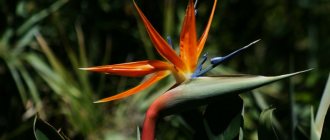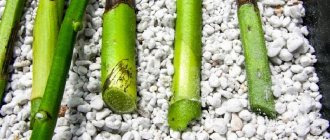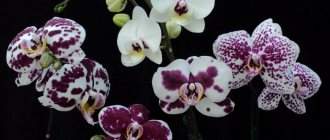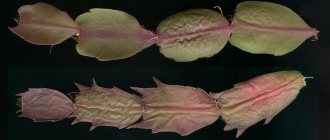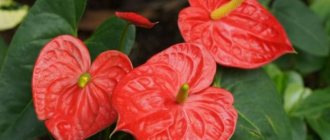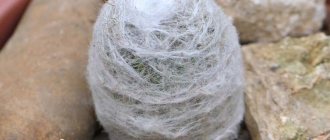Decembrist has many botanical names: Schlumberger cactus, epiphyllanthus, epiphyllum, zygocactus. Among gardeners, they are often called Rozhdestvennik, Christmas cactus, and Decembrina. Belongs to the genus of epiphytic cacti. Its name in common parlance is due to the fact that flowering occurs during the Christmas holidays.
Epiphyllum is the “black sheep” among cacti. Free from thorns, afraid of the sun, has flat leaves made of segments (links) with jagged edges. Showy clusters of tubular flowers appear at the ends of the plant.
The color was originally red, but thanks to the work of breeders, the Christmas tree flaunts yellow, purple, crimson, white and even several flowers at once on one plant.
His home is the tropics in southwest Brazil. Zygocactus grows on trees. Despite the rainfall in these places, little moisture and nutrients remain on the crown and branches. Therefore, caring for Decembrists is simple and the plant is suitable for beginning gardeners.
Brief overview of the article
- Secrets of lush flowering
- Priming
- Top dressing
- Light and temperature
- Watering
- Pruning and propagation
- How does pruning happen?
- Transplantation and propagation
- Pests and their control
- General preventive measures
- Common mistakes in care
- Photo of the Decembrist
Secrets of lush flowering
The secrets are simple, but it’s worth learning the intricacies of caring for a flower. Then photos of exotic Decembrist flowers will delight your loved ones.
Where to buy planting material?
- The best place to purchase hybrid varieties of zygocacti are specialized stores or nurseries that breed this plant.
- Another option, very common these days, is online shopping . But you should resort to the services of sites with an excellent reputation so as not to receive low-quality planting material.
- You can turn to private advertisements and negotiate with an individual about the purchase. At the same time, there is a pleasant “cheapness” feeling, but it is not a fact that you will not become a victim of deception and, under the guise of a unique yellow Schlumbergera, you will receive an ordinary “grandmother’s” Decembrist.
Prices for exotic varieties of zygocacti are, to put it mildly, “biting”:
- for unrooted cuttings they charge from 300 to 500 rubles per piece;
- a rooted cutting can cost from 500 to 1500 rubles per copy;
- but for an adult plant you will have to pay up to several thousand rubles ( from 3000 to 7000 ).
Priming
The soil must allow moisture and air to pass through. If you make the soil yourself, the base is sand and leaf humus in equal proportions.
You can add a little charcoal or peat. A no-fuss option is a universal primer. The soil is not suitable for cacti (excess peat).
general information
In fact, Decembrist or Schlumbergera is an epiphytic cactus native to the Brazilian tropics. It grows on other trees and stores moisture and nutrients abundantly in its segmented stems. Another name for Decembrist is zygocactus.
Unlike many epiphytes, Decembrist is not a parasite. He simply clings to trees and hides in their shade, but gets his own food. The average length of the shoots is about 40 cm, and they consist of flat, jagged or rounded links. New segments gradually grow from existing segments, and in winter buds appear at the tips of the stems.
Pink and red Decembrists are most often found, but breeders have already managed to develop a greater variety of shades. The flowers are multi-tiered, bizarre funnel-shaped, up to 8 cm and up to 30 petals each.
Photo: mandarin-shop.ru
Light and temperature
Epiphyllum loves light, but not direct light. Pots are placed next to windows facing north. The plant is placed towards the south under the condition of shade or diffused light.
The flower is so unpretentious that it grows and pleases with bright buds even at +10-15 degrees. The optimal range is +18-25 °C. Doesn't like sudden changes in temperature.
Lighting
As already noted, this cactus does not like direct and hot sunlight. For him, the shadow is cuter.
It is very important to maintain the correct color regime during its flowering period.
Watering
Christmas trees are watered more often than ordinary cacti, but they are guided by the time of year. During flowering, it is watered frequently, focusing on 1-3 cm of dried soil. After flowering, gardeners reduce the frequency of watering and moisten the soil when it is completely dry.
In summer, showering or wiping the leaves with a damp cloth is important for zygocactus. Water the plant with water at room temperature. Cold tap water will kill the roots.
Briefly about the plant
The Decembrist did not receive its name during its appearance in Europe. Everything is even simpler here.
In fact, those who are more familiar with it have noticed that its flowering itself occurs in the winter month of December. That's the whole reason.
This not only surprises many flower growers, but is also very touching, since such multicolored flowers are unlikely to be seen anywhere else.
Pruning and propagation
Pruning is necessary after the plant has flowered. Long drooping leaves are beautiful, but the nutritional elements will not reach the flower. For lush flowering, you should form a crown that is slightly larger than the diameter of the pot.
Important! If a plant has smaller flowers than in the previous year, this is a signal: the necessary substances do not reach them.
Top dressing
Many people believe that it does not require any feeding. Not only experienced flower growers are sure of this, as they write in many books on caring for indoor plants. But there is an exception to every rule.
Feeding needs to be done for such an unusual cactus. But it’s only worth doing it during a period of very active growth. This time falls on warm summer days.
How does pruning happen?
For pruning, no tools are needed except the caring hands of the housewife. You should hold the sheet from below and make twisting movements. The leaf segments come off easily.
If the plant is many years old, some leaves will branch in two directions, forming the English letter Y. To trim them, you need to leave 1 segment of the branch on each side.
This is interesting: After pruning, the flower can bloom again in March.
History of the creation of the species
Decembrist Gold Charm is the first yellow plant variety. This species was obtained through the efforts of the American breeder R. L. Cobia in the 80s of the last century. The difficulty of breeding was that in nature there are species with an orange-red tint, but not with yellow ones.
First of all, species with a predominance of yellow over red were selected, since orange is a combination of red and yellow. As a result, about 50 thousand seeds were obtained. But only 1 plant of them had a yellowish color, although the bush itself was very weak.
To correct this, the plant was re-crossed, but with a white variety of the crop, characterized by a strong skeleton and a long flowering period. Of the 150 specimens ultimately received, only 1 flower had a soft yellow color, but the bush was well formed and had strong shoots. It was this plant that became the basis of the Gold Charm variety.
Transplantation and propagation
A young plant needs to be replanted every year. For Zygocactus that is more than 5 years old, the container is changed as needed.
After flowering, in early spring, the zygocactus is replanted. In water, the cuttings may not take root, so they are planted directly in a pot with holes. Ideally, replanting is combined with pruning.
Planting Decembrist flowers is not difficult. Useful:
- 3 cuttings with two segments per 1 pot;
- small pots;
- expanded clay;
- vermiculite 1/10 (mineral to keep the soil loose);
- universal primer;
- small spatula or mixing tool.
Expanded clay is poured onto the bottom, filled with soil and vermiculite, mixing the last two ingredients with a shovel. You can fill it almost to the edges of the container, make a small depression and pour in a little water.
Next, plant 3 cuttings per pot. This way they will take root faster and create a root system. The cutting needs to be deepened into the ground by half a segment. It is important to monitor soil moisture and do not overwater.
Signs of the Decembrist flower at home
Various signs and superstitions are associated with this flower. It is believed that he can not only talk about the energy of the guests at home, but also about the approach of death in it.
Decembrist is a flower; various signs can be associated with it. Many are afraid to keep it in the house, as it begins to wither and wither if it feels the breath of death. This is what is known in magic today about this creation of nature.
Can this flower destroy the energy in the house? Modern magicians believe that there is nothing to fear, since the Decembrist only warns of death. It does not affect the energy in the house in any way, but is very sensitive if there is negativity. People believe that if there is this flower in the house, then in front of the deceased in the house it begins to shed its leaves and wither.
For this reason, the Decembrist tried not to keep it in the house - no one wanted to know in advance about death, especially about their own. Even in ancient times, there was a sign that a dead flower - the Decembrist - takes a living person with it to another world. Although at the same time, many refuted such a superstition, believing that if there are no sick people in the house, the omen will not come true.
In fact, modern magicians are inclined to believe that the Decembrist can warn about sudden death in the house and funerals, but he himself has nothing to do with it. But there are several other signs that may indicate what the Decembrist is indicating in the house.
Pests and their control
The Christmas tree is susceptible to serious illnesses. They are divided into fungal, bacterial and insect-related diseases.
Fungi include:
- Pathogens of fusarium. Signs lie in dry, light lesions on the edges of the shoots. Fungal spores are easily airborne. If left untreated for a long time, the root system dies.
- Pathogens of late blight. The leaves acquire a dull gray tint and wither. In the root area, the stems rot, and the segments on the Decembrist crumble.
- Cladode rot. The spores on the leaves are black in color and take on a round shape.
Chemical fungicides are used to treat fungal infections. These can be “Fundazol”, “Fitosporin”, copper sulfate solution (Bordeaux mixture).
Attention! The healthy part of the plant can be cut, but it must be pre-treated with a fungicide.
Of the bacterial types, soft rot occurs. The lesion is black, slimy, starts from below at the soil line and spreads to the leaves. It is better not to joke with excessive feeding and humidity; remove diseased leaves in a timely manner. Chemical treatment is ineffective.
Uninvited insect guests also cause trouble.
- The activity of a spider mite can be determined by a rusty coating, white spots on the leaves and cobwebs. The resident himself comes in yellow, brown and scarlet colors. When such signs appear, use the drugs “Actellik”, “Neoron”, “Fitoverm”. It is necessary to treat the affected plant and its neighbors. Wipe the window sills with alcohol.
- The work of the scale insect is determined by brown spots at the bottom of the leaves in the center, loss of shine in the plant, and the absence of new shoots. You need to clean off the insects with a brush or rag dipped in soapy water. Treat the plant and pot with Fitoverm.
- Mealybugs leave cotton balls on leaves and flowers on the top or back side. Remove the discharge with a brush. Zygocactus is treated with a soap solution (half soap per liter of water, left overnight) and sprayed 4 times with an interval of 2 weeks.
What colors are Christmas trees?
There are a lot of varieties, their differences relate to the color and shape of the petals . The stem segments differ in size and, in some rare cases, color.
- Schlumberger with a white flower looks very attractive:
- White Christmas;
- Angel Dance;
- White Bell;
- Aspen;
- Madame Butterfly.
Bridgeport;
White Decembrist is a light-loving plant, but direct sunlight can cause burns on the flower stems. The segments of white Decembrists are dark green in color. In the center of the shoot there is a pronounced vein.
Reference! When temperatures are too low, the pure white petals of hybrid varieties take on a pink tint.
The group of white varieties and hybrids includes plants with a cream color.
White flowers are characteristic of Aspen and White Christmas varieties, and yellow flowers are characteristic of Golden Cream. The Santa Cruz variety, artificially bred, has an orange color. For the Decembrists, yellow is not a typical color. But the breeders' many years of work were not in vain. The following varieties have been developed:
- Christmas flame;
- Cambridge;
- Twilight Tangerine.
They differ from other zygocacti in the shades of their flowers: from pale yellow to rich gold. The length of the bud can reach 9 cm.
Common mistakes in care
Frequent rearrangement of the flower from place to place. Although caring for a Decembrist at home is simple, he will not tolerate a permanent change of residence. A banal turning of the pot will bring stress to the Christmas boy. Especially during flowering: it will drop flowers.
In winter it is not artificially illuminated.
No rest period for 1.5 months (approximately September-October). After a summer with intensive watering and fertilizing, the plant must be placed in a room with low temperatures and watering should be practically eliminated. This is easy to do: in city apartments it is cool until the heating is turned on, this can be called a period of rest.
Tip: To avoid confusion with watering, you can make a sign or sticker that says “Don’t water me.”
Transplant into a large pot. The root system of the Schlumbergera cactus is small. Flowering will occur in 3-5 years.
Decembrist with exotic showy flowers is a godsend for a gift, especially during the New Year holidays. A minimum of effort in care, if you know the intricacies of the flower, will delight the owner for decades.
Seasonal care features
In the first two months of winter, Decembrist will become a magnificent decoration for your room, blooming inflorescences in the form of bells with pointed edges.
Provide it with regular watering and special feeding. Just don't move it! In February, water less and create a cool climate. Until the middle or end of March, the plant will be in a state of rest.
The period from late April to mid-May is suitable for propagation and transplantation of zygocactus. It is propagated by cuttings, which should first be slightly dried for about 2-3 days so that a transparent film covers the cut.
Then root it in prepared soil of leaves, turf and sand in a ratio of 2:1:1 with the addition of pre-crushed charcoal. Be sure to make drainage from expanded clay at the bottom of the flower pot.
In the summer, send the Decembrist to breathe on the balcony, having previously taken care of protecting it from the open sun. Water deeply, but do not overwater.
- Bacopa - description of the species, cultivation, care, reproduction + 74 photos
- Garden hibiscus - types, description, planting, care and propagation + 69 photos
- Celosia - growing from seeds and seedlings, planting in the ground and care rules + 80 photos
With the onset of autumn, the flower begins to prepare for blooming. Smoothly reduce watering, let the plant freeze a little, sending it to a cool room with a temperature of up to 10-14°C.
Poor watering and sufficient coolness will inspire the plant to produce abundant buds. In November bad weather, when the period of bud formation begins, water the flower more abundantly and place it in a warm place with a temperature of at least 15°C.
